You searched for: 河南福彩22选5走势图大星彩【杏彩体育qee9.com】6OjqT
<< Previous | Displaying results 176-200 of 423 for "河南福彩22选5走势图大星彩【杏彩体育qee9.com】6OjqT" | Next >>
-
Embroidered matzah cover
ArtifactFollowing the Soviet occupation of Lithuania, the Lifszyc family began to search for ways to leave the country. David Lifszyc obtained a Curacao visa from the Dutch consulate. He also obtained an American visa because he was included on a list of distinguished rabbis submitted to the State Department by the Agudat Israel of America. After obtaining Soviet exit visas, the Lifszycs purchased tickets for Vladivostok on February 5, 1941. They started for Moscow, where they received Japanese transit visas. This…
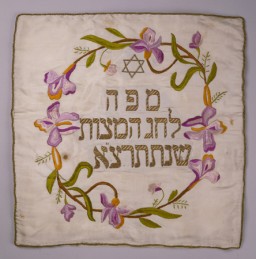
-
European Jewish population distribution, ca. 1933
MapJews have lived in Europe for more than two thousand years. The American Jewish Yearbook placed the total Jewish population of Europe at about 9.5 million in 1933. This number represented more than 60 percent of the world's Jewish population, which was estimated at 15.3 million. Most European Jews resided in eastern Europe, with about 5 1/2 million Jews living in Poland and the Soviet Union. Before the Nazi takeover of power in 1933, Europe had a dynamic and highly developed Jewish culture. In little more…

-
Jakub Lapides
ArticleYoung people's diaries bear witness to some of the most heartbreaking experiences of the Holocaust. Learn about the diary and experiences of Jakub Lapides.
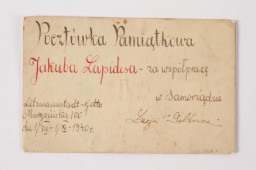
-
Theresienstadt: SS and Police Structure
ArticleLearn more about the unique SS and police structure of the Theresienstadt “camp-ghetto” during World War II.
-
Jewish Population of Europe in 1933: Population Data by Country
ArticleBefore the Nazis seized power in Germany in 1933, Europe had a richly diverse set of Jewish cultures. Learn more about the Jewish population of Europe.

-
The Enabling Act
ArticleThe Enabling Act of March 1933 allowed the Reich government to issue laws without the consent of Germany’s parliament. It laid the foundation for the Nazification of German society.

-
Law for the Imposition and Implementation of the Death Penalty
ArticleLearn more about the Law for the Imposition and Implementation of the Death Penalty, which the Nazis enacted after the Reichstag Fire Decree in 1933.
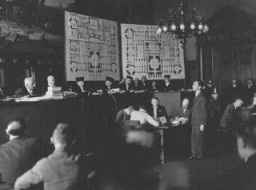
-
Abba Kovner
ArticleRead the Jewish Partisan Educational Foundation's short biography of Abba Kovner.
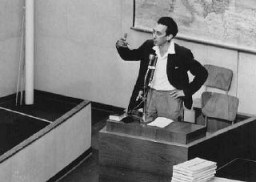
-
The 80th Infantry Division during World War II
ArticleThe 80th Infantry Division participated in major WWII campaigns and is recognized for liberating Buchenwald and the Ebensee subcamp of Mauthausen in 1945.
-
The Bielski Partisans
ArticleUnder the protection of the Bielski partisan group, founded by brothers Tuvia, Asael, and Zus, over 1,200 Jews survived after fleeing into forests in western Belarus.
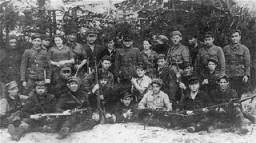
-
World War II in Europe
ArticleGermany started World War II in Europe on September 1, 1939, by invading Poland. War would continue until 1945. Learn more about WWII and genocide in Europe.
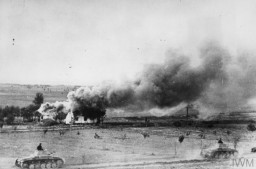
-
Polish Jews in Lithuania: Escape to Japan
ArticleAfter 1940, Polish refugees were pressured to leave Lithuania. Learn more about the diplomats that assisted them and their journey to Japan.
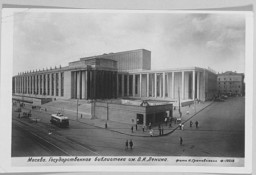
-
Genocide Timeline
ArticleKey dates in the use of the term genocide as part of the political, legal, and ethical vocabulary of responding to widespread threats of violence against groups.

-
Moringen Youth Camp
ArticleThe Moringen camp was one of the so-called youth protection camps that the Nazi regime established for young people who were alleged to have strayed from Nazi norms and ideals.
-
Drancy
ArticleThe Germans established an internment camp at Drancy in August 1941. The following summer, Drancy became the main transit camp for deportations of Jews from France.

-
Soviet Secret Police massacre in Lvov
FilmThe Soviet Union occupied Lvov in September 1939, according to secret provisions of the German-Soviet Pact. Germany invaded the Soviet Union on June 22, 1941. After a week of bitter fighting, German forces occupied Lvov. They discovered that the Soviet Secret Police had massacred thousands of prisoners, mostly Ukrainian nationalists, before fleeing from the city. This footage shows the removal of the bodies of some of those massacred. The Germans claimed that the city's Jewish population had supported the…
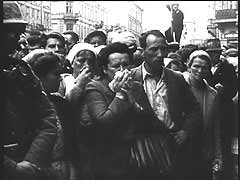
-
Jews from Macedonia before deportation
PhotoJews from Bulgarian-occupied Macedonia who were rounded up and assembled at the Tobacco Monopoly transit camp in Skopje before deportation to the Treblinka killing center. Skopje, Yugoslavia, March 1943. The Jews of Bulgarian-occupied Thrace and Macedonia were deported in March 1943. On March 11, 1943, over 7,000 Macedonian Jews from Skopje, Bitola, and Stip were rounded up and assembled at the Tobacco Monopoly in Skopje, whose several buildings had been hastily converted into a transit camp. The…
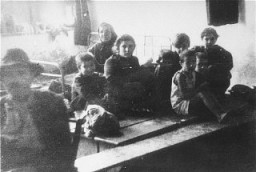
-
Macedonian Jews leave the Tobacco Monopoly transit camp in Skopje for the deportation trains
PhotoMacedonian Jews leave the Tobacco Monopoly transit camp in Skopje for the deportation trains. Skopje, Yugoslavia, March 1943. The Jews of Bulgarian-occupied Thrace and Macedonia were deported in March 1943. On March 11, 1943, over 7,000 Macedonian Jews from Skopje, Bitola, and Stip were rounded up and assembled at the Tobacco Monopoly in Skopje, whose several buildings had been hastily converted into a transit camp. The Macedonian Jews were kept there between eleven and eighteen days, before being…
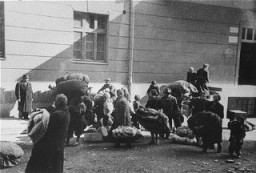
-
Presenting the prosecution's case at the International Military Tribunal
PhotoUS Major Frank B. Wallis (standing center), a member of the trial legal staff, presents the prosecution's case to the International Military Tribunal at Nuremberg. A chart (top left) shows where the defendants (bottom left) fit into the organizational scheme of the Nazi Party. At right are lawyers for the four prosecuting countries. Nuremberg, Germany, November 22, 1945. The trials of leading German officials before the International Military Tribunal are the best known of the postwar war crimes trials.…
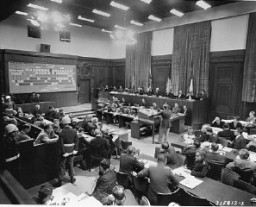
-
Jews from Macedonia before deportation to the Treblinka killing center
PhotoJews from Macedonia who were rounded up and assembled in the Tobacco Monopoly transit camp before deportation to the Treblinka killing center. Skopje, Yugoslavia, March 1943. The Jews of Bulgarian-occupied Thrace and Macedonia were deported in March 1943. On March 11, 1943, over 7,000 Macedonian Jews from Skopje, Bitola, and Stip were rounded up and assembled at the Tobacco Monopoly in Skopje, whose several buildings had been hastily converted into a transit camp. The Macedonian Jews were kept there…

-
Jews outside the Monopol tobacco factory transit camp
PhotoJews outside the Monopol tobacco factory, used as a transit camp by Bulgarian authorities during deportations from Macedonia to the Treblinka killing center in German-occupied Poland. Skopje, Yugoslavia, March 1943. The Jews of Bulgarian-occupied Thrace and Macedonia were deported in March 1943. On March 11, 1943, over 7,000 Macedonian Jews from Skopje, Bitola, and Stip were rounded up and assembled at the Tobacco Monopoly in Skopje, whose several buildings had been hastily converted into a transit camp.…

-
Jews prepare soup outside the Monopol tobacco factory transit camp
PhotoJews prepare soup outside the Monopol tobacco factory, used as a transit camp by Bulgarian authorities during deportations of Jews from Macedonia. Skopje, Yugoslavia, March 1943. The Jews of Bulgarian-occupied Thrace and Macedonia were deported in March 1943. On March 11, 1943, over 7,000 Macedonian Jews from Skopje, Bitola, and Stip were rounded up and assembled at the Tobacco Monopoly in Skopje, whose several buildings had been hastily converted into a transit camp. The Macedonian Jews were kept there…
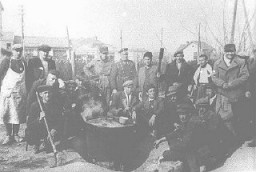
-
Macedonian Jews prepare to board a deportation train in Skopje
PhotoMacedonian Jews prepare to board a deportation train in Skopje. Skopje, Yugoslavia, March 1943. The Jews of Bulgarian-occupied Thrace and Macedonia were deported in March 1943. On March 11, 1943, over 7,000 Macedonian Jews from Skopje, Bitola, and Stip were rounded up and assembled at the Tobacco Monopoly in Skopje, whose several buildings had been hastily converted into a transit camp. The Macedonian Jews were kept there between eleven and eighteen days, before being deported by train in three transports…

-
Debate within the Lokacze Ghetto
ArticleDifficult debates took place within ghettos about whether and how to resist under the most adverse conditions. Read a rare account from the Lokacze ghetto.
